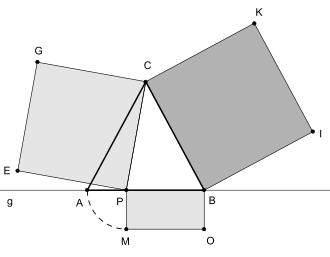Thigh transversal set
The thigh transversal theorem is a set of elementary geometry using isosceles triangles . It describes the equality of area of certain rectangles, which are created by the intersection of the isosceles triangle with a certain transversal . In a special case, the theorem also provides the Pythagorean theorem and can therefore be regarded as its generalization. However, the theorem can also be proven with the help of the Pythagorean theorem, so that both theorems are ultimately equivalent or logically equivalent. The sentence also follows from Stewart's theorem .
The thigh transversal proposition is said to appear in the elements of Euclid (around 300 BC).
Formulation of the sentence
Consider an isosceles triangle with the base and the tip . The straight line running through the base is denoted by.
Let there be a transversal line through the tip of , which intersects at a point .
Then:
- ,
if not on the route and
- ,
if lies between and .
proof
The height divides the base of the isosceles triangle into two equal sections. It also provides the right-angled triangles and , to which the Pythagorean theorem is applied. This results in two equations from which the statement of the sentence follows.
Case 1: is outside of
- If you solve the second equation and insert the value for in the first equation, you get:
Case 2: is within
- If you solve the second equation and insert the value for in the first equation, you get:
Pythagorean theorem as a special case
If you consider the special case in which the base is in the middle , the height of the isosceles triangle is identical and the rectangle is a square. The Pythagorean theorem then applies to the right-angled triangle . For any right-angled triangle, by mirroring it on one of its two legs, you always get an isosceles triangle in which the transversal law applies and provides you with the Pythagorean theorem.
literature
- Heinrich Dörrie : Der Schenkel-Transversal Satz , magazine for mathematical and scientific teaching 53, 1922, S. 8-14 ( yearbook review )
- Theophil Lambacher , Wilhelm Schweizer (Ed.): Lambacher-Schweizer . Mathematical teaching material for higher schools . Geometry. 13th edition. Edition E. Part 2. Ernst Klett Verlag, Stuttgart 1965.
Individual evidence
- ^ Theophil Lambacher , Wilhelm Schweizer (ed.): Lambacher-Schweizer . Mathematical teaching material for higher schools . Geometry. 13th edition. Edition E. Part 2. Ernst Klett Verlag, Stuttgart 1965, p. 104 .
- ↑ In Lambacher-Schweizer, p. 232, the thigh transversal theorem is associated with the sentence group of Pythagoras as follows : “The oldest proven evidence comes from Euclid (around 300 BC) and crowns the 1st book of its elements Euclid proceeds after ... and first proves the cathetus set . He also brings the height theorem , the general Pythagorean theorem ... and the thigh transversal theorem ”.





























